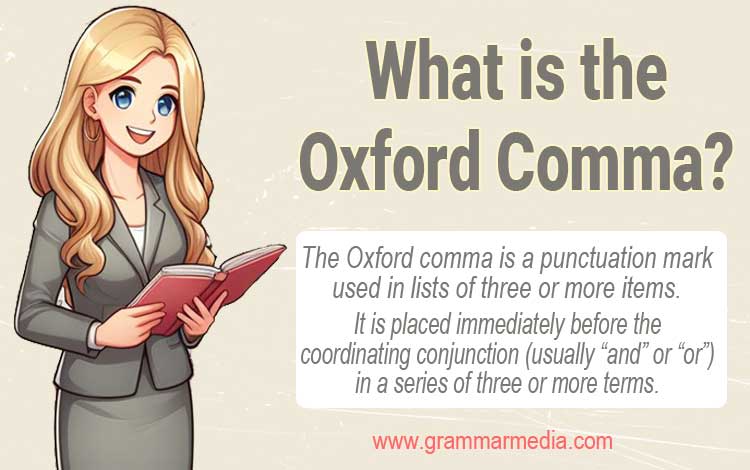The Oxford comma, also known as the serial comma or Harvard comma, is a punctuation mark used in lists of three or more items. It is placed immediately before the coordinating conjunction (usually “and” or “or”) in a series of three or more terms or items.

What is the Oxford Comma?
Definition: The Oxford comma, also known as the serial comma or Harvard comma, is a punctuation mark used in English writing. It is placed immediately before the conjunction (usually “and,” “or,” or “nor”) in a list of three or more items.
For example:
- Jenny enjoyed hiking, reading, and writing in her spare time.
- My favorite colors are red, blue, and green.
- The benefits of regular exercise include increased energy, imporved mood, and beter overall health.
- The movie had action-packed scenes, colorful characters, and stunning visuals.
- My latest assignment required research, analysis, and critical thinking skills.
NOTE: The Oxford comma is also known as the serial comma because it is used in a series of three or more items or terms. It is called a serial comma because it is placed immediately before the coordinating conjunction in a series of three or more items or terms.
NOTE: The Harvard comma is another name for the Oxford comma. It is called the Harvard comma because it is used by the Harvard University press, which has a style guide that recommends its use. Check out the following link – Harvard Style Guide Lines For Serial Comma.
What is the History of the Oxford Comma?
The Oxford comma, also known as the serial comma, traces its historical roots to the sixteenth century. Initially emerging as a punctuation phenomenon during this period, its early use lacked specialization, serving various functions in both handwritten and printed documents. The seventeenth century witnessed a broad range of roles for the comma, with a gradual increase in usage, particularly in printed texts or documents.
As time progressed into the eighteenth and nineteenth centuries, the serial comma became more entrenched, evolving from a mere convention to a rule, notably in late Modern English. Prescriptive grammarians of this era played a significant role in advocating for its usage, emphasizing its importance irrespective of the presence of ambiguity. Influential publications like the Oxford English Dictionary and The Encyclopedia Britannica further endorsed the serial comma, contributing to its wider distribution.
In the twentieth century, a noticeable shift in attitude towards punctuation styles occurred. From the mid-century onwards, there was a move from a close to an open style of punctuation. This shift, coupled with the expansion of mass media, particularly in newspapers, led to a drastic decline in the use of the serial comma. By 1980, its omission had become the standard practice in Present-day British English, marking a significant evolution in the history of this punctuation mark.
Source Material: Javier Calle-Martín & Miriam Criado-Peña (2022) ‘A very pleasant, safe, and effectual medicine’: The serial comma in the history of English, Australian Journal of Linguistics, 42:2, 165-183. Link to this article: The Serial Comma in the History of English.

What is the Purpose of the Oxford Comma?
The Oxford comma serves a crucial role in bringing clarity to written communication. Its primary purpose is to avoid ambiguity by separating items in a list and making it clear where each element begins and ends.
This tiny punctuation mark, placed before the conjunction in a series, helps prevent confusion and ensures that the reader understands the intended meaning of the sentence.
Let’s look at a couple of examples:
- The teacher praised the students, Lisa and Lionel.
- The teacher praised the students, Lisa, and Lionel.
Summary: Without the Oxford comma, it may be misconstrued that Lisa and Lionel are the only students being praised.
- Rachael Ray finds inspiration in cooking her family and her dog.
- Rachael Ray finds inspiration in cooking, her family, and her dog.
Summary: Without the Oxford comma, confusion may arise, leading to unintended meanings.
NOTE: In legal documents, journalism, and other professional writing, precision is of most importance. The Oxford comma serves as a linguistic beacon, guiding readers through a sea of words with unequivocal clarity. Ambiguity in communication can lead to misunderstandings, legal disputes, and unintended humor, all of which the Oxford comma seeks to prevent.
Detractors may argue that the Oxford comma is superfluous, but its absence can create confusion, altering the intended meaning of a sentence. In the age of rapid communication and diverse writing styles, the Oxford comma stands as a timeless tool for maintaining clarity and precision.
The purpose of the Oxford comma is simple yet profound. It eradicates ambiguity in sentences with three or more terms or items. This punctuation mark, often overlooked, is a powerful ally in the quest for precision in language. Embracing the Oxford comma is not just a matter of personal preference; it’s a commitment to clear and unambiguous communication, ensuring that our words convey exactly what we intend.
What are the PROS and CONS of the Oxford Comma?
Let’s look at five pros and cons of the Oxford comma!
1. It has supporters and critics
People have different opinions about the Oxford comma. Some think it’s great, while others don’t like it much. It’s like when you ask your friends about a new video game – some love it, and some say it’s not their thing.
2. Supporters say it helps avoid confusion
Those who like the Oxford comma say it helps make sentences clear. It’s like using signposts in writing to show where one thing ends and the next begins. Without it, sentences might get a bit confused and mixed up, like telling a story without saying who’s who.
3. Critics say it’s extra and makes sentences messy
On the other hand, people who don’t like the Oxford comma think it’s like adding too many decorations to a cake. They believe sentences should be simple and not have too much punctuation. It’s a bit like choosing between a plain cake and one with lots of toppings.
4. People have strong or not-so-strong feelings
Some folks really care about the Oxford comma. It’s like having a favorite sports team – they defend it with passion. Others are more chill, saying, “Eh, whatever works.” It’s a bit like choosing between two snacks – some people have a clear favorite, while others are easygoing.
5. It’s your choice in the end
Deciding to use the Oxford comma is like picking your favorite outfit. It’s all about what feels right for you. No strict rules say you have to use it or not – it’s your own writing style, like choosing the color of your backpack or the design on your notebook.

Why is the Oxford comma so controversial?
The reason the Oxford comma is controversial is because different publishers have different guidelines. Some publishers mandate the Oxford comma while others advise against it.
Note the following style guidelines:
- The APA style, The Chicago Manual of Style, Garner’s Modern American Usage, The MLA Style Manual, Strunk and White’s The Elements of Style, and the U.S. Government Printing Office Style Manual recommend or mandate it.
- The Associated Press Stylebook and The New York Times Style Book advise against it.
- The stylebook published by The Canadian Press advises against it.
- Most British style guides do not mandate its use.
- The Economist Style Guide notes that most British writers use it only where necessary to avoid ambiguity.
- A few British style guides mandate it, most notably The Oxford Style Manual (hence the name, “Oxford comma”).
- However, the University of Oxford Style Guide (2014) advises against its use.
The debate over the Oxford comma persists even today, with writers and editors adopting different preferences based on their linguistic perspectives and the style guides they follow. Advocates believe it ensures precision in communication. Opponents argue that it is redundant and disrupts the flow of the sentence. (so the debate continues)
What is an Oxford Comma Example?
Here are 5 examples of “what is the Oxford comma” in use!
- Rachel likes reading, studying and writing in her spare time. (without Oxford comma)
- Rachel likes reading, studying, and writing in her spare time. (with Oxford comma)
- The scientist conducted experiments, gathered data and published research papers. (without Oxford comma)
- The scientist conducted experiments, gathered data, and published reseach papers. (with Oxford comma)
- James’ hobbies included photography, painting and sculpting. (without Oxford comma)
- James’ hobbies included photography, painting, and sculpting. (with Oxford comma)
- David planted beans, lettuce and Kale in the garden. (without Oxford comma)
- David planted beans, lettuce, and kale in the garden. (with Oxford comma)
- Peter played basketball, soccer and tennis. (without Oxford comma)
- Peter played basketball, soccer, and tennis. (with Oxford comma)
For more information about what is the Oxford comma, click on the following link – 8 Basic Comma Rules